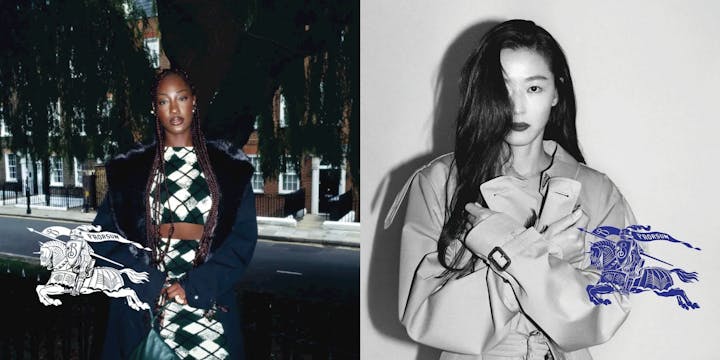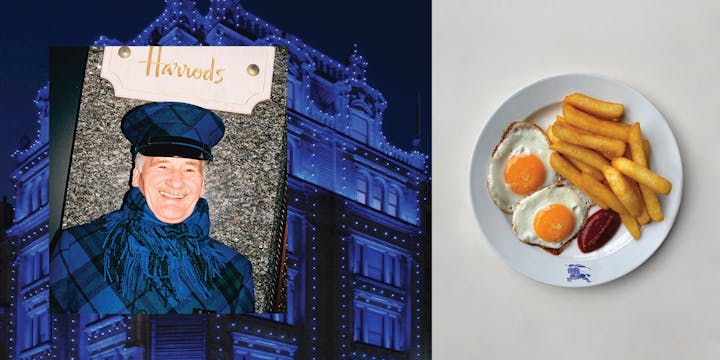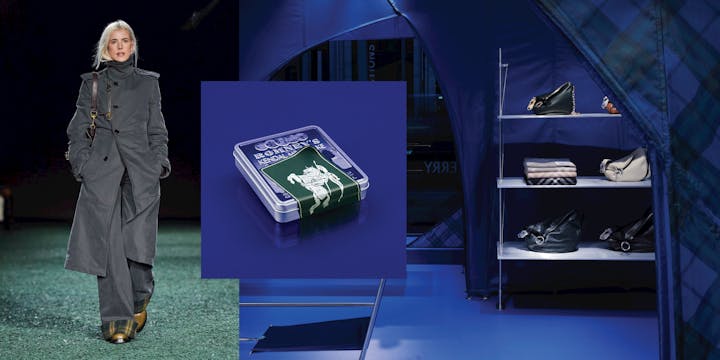3X WAYS BURBERRY LOOKED BACK TO REIMAGINE ITS FUTURE
Not too long ago Burberry didn’t sit high on our luxury radar. Other big players – like Louis Vuitton, Moncler, and Gucci – were arguably more interesting and Burberry felt, for the most part, expected. They were stuck in the world of old luxury and still repairing the reputational damage caused by the ‘chav-check’ explosion of the 2000s.
Luckily, there’s nothing like the appointment of a visionary creative director to revive an antiquated brand and make it exciting again. Daniel Lee has been at the helm of Burberry since late 2022, and so far in his tenure he’s created a brand universe that has become increasingly more captivating. And much cooler.
Lee’s strategy? Looking backwards to Burberry’s own past to reimagine its future through a contemporary lens. It’s a trend we’re increasingly seeing progressive luxury brands jumping on, as they continue to try and win the affections of an emerging, heritage-obsessed Gen-Z consumer.
Here are three ways Burberry is twisting its own heritage and updating traditions to exist in the fast-moving fashion scene:
1. ARCHIVAL BRANDING
We all remember the great logo simplification movement of 2017, which saw luxury brands stripping back their logos to bold, sans-serif, and frankly quite soulless, icons. A trend that became known as ‘blanding’.
So when Burberry revealed its rebrand last year, the design community was pleasantly surprised to see the return of the brand’s illustrative icon and distinctive serifed word marque. A breath of fresh air and distinguishability in the fashion world.
Burberry originally adopted the intricate Equestrian Knight symbol in 1901. Over 100 years later, Daniel Lee’s first creative expression as Creative Director was to look back through the archives and introduce a refreshed version of it, fit for the modern world.

Image: Burberry
The symbol has worked hard since its reintroduction. A quick scroll on the brand’s Instagram page and you’ll see it blown up and smashed against street-style photography, coloured-up in electric blue, supersized as a belt buckle, and even donned by Mary Berry in the form of a silk scarf.
Burberry may have pulled its iconic horse symbol from the past, but the way it shows up is anything but twee - instead it’s playful, bold, juxtaposing, and surprisingly contemporary.
2. REFRESHED TRADITIONS
For a luxury brand to thrive, storytelling is more important than ever. Lee realises this and has responded with a defined brand narrative for Burberry based around British character. During his reign, he’s been consistently communicating this in new and innovative ways.
In the past year, the fashion house has orchestrated a string of patriotic takeovers, part of which was the controversial makeover of London’s Underground, where Bond Street tube station became a blue ‘Burberry Street’. “It caused a bit of a stir,” said Daniel Lee, “you’ve got to be provocative.”

Image: Burberry
There was also the viral partnership with Normans, a hipster iteration of a classic British greasy spoon caff. And most recently, social feeds were filled with snaps of a bright ‘knight blue’ Harrods facade where, for the first time ever, Harrods’ doormen swapped out their iconic green-clad uniforms for a pattern taken from Burberry’s Spring 2024 collection. A great example of two legends coming together and exchanging equity, the takeover saw new-luxury status traded for total quintessential Britishness.
3. DIALLING UP BRITISH NOSTALGIA
Since Lee’s inception, Burberry has been tapping into British nostalgia in a big way. In recent fashion shows, iconic Britpop models, Agyness Dean and Naomi Campbell, were pulled out of retirement to walk the runway to the soundtrack of Amy Winehouse. As a nod to Britain’s famous drizzle, models carried umbrellas and paired rubber mules with anoraks.
Continuing the theme, recent pop-up stores have paid homage to Burberry’s ‘heritage of exploration’, displaying special versions of Romney’s Kendal Mint Cake and limited-edition orienteering maps underneath tent-like structures. A move that evoked childhood memories of rainy camping trips represented through a luxury lens.

Image: Burberry
This eccentricity and inclusivity of 21st-century Britain is part and parcel of Burberry’s appeal to a nostalgia-hungry global audience. It’s a sentiment that isn’t that isn’t lost on Burberry, and one that’s helped catapult them to renewed success in recent years. We can’t wait to see what they do next.
Words by Ella Palmer, Culture.
SEEN is our monthly-ish 3x3 newsletter about brands, trends and creativity. Subscribe by getting in touch here: hello@lovecreative.com.